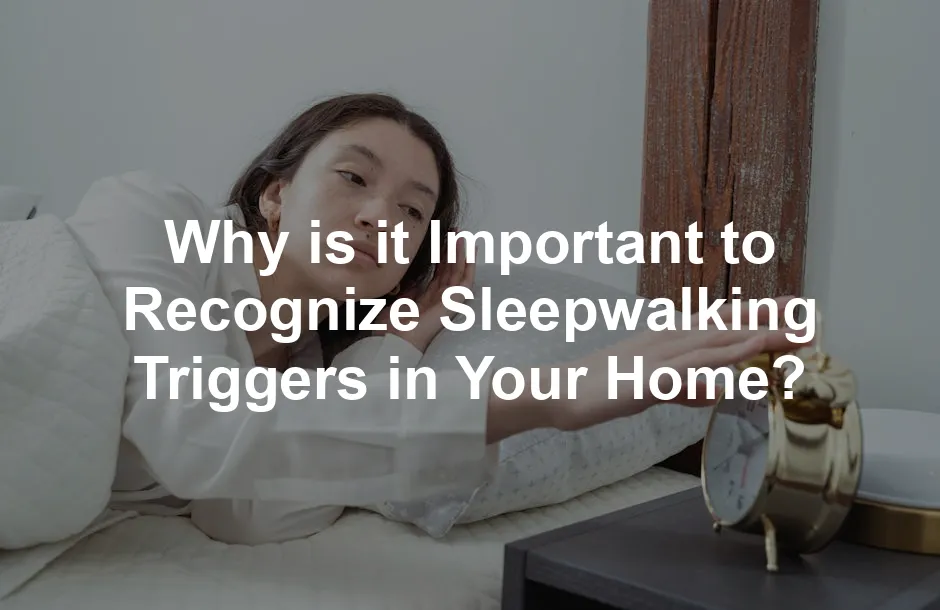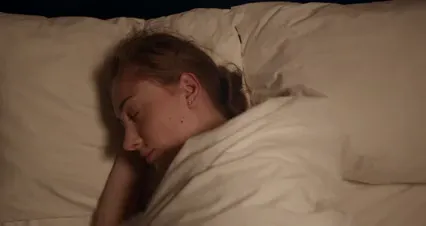
Why is it Important to Recognize Sleepwalking Triggers in Your Home?
Introduction
Sleepwalking – the midnight escapade that can turn your tranquil home into a scene straight out of a comedy. Imagine waking up to find your loved one wandering the halls with glazed eyes, blissfully unaware of their nighttime adventures. While this phenomenon may seem harmless or even amusing, it’s essential to recognize the triggers of sleepwalking in your home.
Identifying these triggers can help prevent potential accidents and ensure a safer sleeping environment for everyone involved. Sleepwalkers often roam about with little awareness, making them susceptible to mishaps. A misplaced chair or an open window could turn their dreamlike wanderings into a hazardous reality. Recognizing triggers also fosters better sleep hygiene, which can reduce the frequency of episodes over time.
In this article, we’ll explore the significance of recognizing sleepwalking triggers, the common causes, and effective strategies to create a safer home. Because let’s face it, no one wants their sleepwalking loved one to end up in the garage thinking they’re on a treasure hunt!
To enhance safety at night, consider installing motion sensor lights around your home. These lights will illuminate pathways automatically, reducing the risk of nighttime accidents for sleepwalkers and anyone else who might need to navigate in the dark.
Understanding that sleepwalking can stem from various factors—including stress, sleep deprivation, and even certain medications—provides insight into managing this quirky condition. By taking proactive steps, you can not only enhance safety but also cultivate a supportive environment where open conversations about sleep disorders can thrive. So, let’s dive into the importance of recognizing these triggers and ensuring sweet dreams for all!

Understanding Sleepwalking
What is Sleepwalking?
Sleepwalking, or somnambulism, is a fascinating condition. It involves getting up and walking around while still asleep. Yes, you heard that right! This sleep disturbance usually occurs during the deepest stages of non-REM sleep. It’s more commonly seen in children, with about 5% to 15% of them experiencing episodes, often outgrowing it by their teenage years. In adults, around 1% to 1.5% encounter sleepwalking, typically linked to other sleep disorders. During an episode, a sleepwalker may perform various activities, like walking, talking, or even engaging in complex tasks, while still in a state of slumber. They might appear dazed or confused, with their eyes wide open but seemingly unaware of their surroundings.
Symptoms of Sleepwalking
So, what should you look out for? Sleepwalking episodes can involve a range of behaviors. Typical signs include walking around the house, sitting up in bed with a glassy-eyed stare, or even talking incoherently. Sleepwalkers often don’t respond to attempts to communicate and can be challenging to wake up. If you do manage to rouse them, they might display confusion or disorientation. Perhaps the most perplexing aspect is the lack of memory upon waking. They won’t remember their midnight escapades, leaving everyone else scratching their heads the next morning!
Causes and Triggers
Sleepwalking is influenced by multiple factors, making it a true mystery. Let’s break down some key triggers.
Genetic Predisposition
Sleepwalking tends to run in families. If a child has a parent who sleepwalks, the chances of them doing the same increase significantly. Genetics play a crucial role in this curious phenomenon.
Sleep Deprivation
Lack of sleep is a major culprit. When individuals don’t get enough rest, their bodies may respond with sleepwalking episodes. Prioritizing sleep is essential for both physical and mental well-being. To help with this, consider using a weighted blanket. These cozy companions can help you feel secure and relaxed, making it easier to drift off into dreamland.
Stress and Anxiety
Stress can wreak havoc on our sleep. Heightened levels of tension or anxiety can lead to disturbed sleep patterns. Managing stress through relaxation techniques, like yoga or meditation, can be beneficial in reducing sleepwalking incidents. Pair your practice with a soothing essential oil diffuser to create a calming atmosphere that promotes relaxation and peace.
Medications and Substances
Certain medications, especially sedatives, can trigger sleepwalking episodes. Alcohol consumption can also destabilize sleep cycles, making them more prone to nocturnal wandering. It’s vital to consult with a healthcare provider if you suspect medications might be contributing to sleepwalking.
Environmental Factors
Lastly, the bedroom environment has a significant impact. Factors like excessive noise, light, or an uncomfortable temperature can disrupt sleep and increase the likelihood of sleepwalking. Creating a calming sleep environment is essential for everyone, especially for those prone to wandering at night. To enhance your sleep environment, consider investing in a white noise machine that can drown out distractions and help you sleep like a baby.
Understanding these causes and triggers is crucial. By taking proactive measures, such as managing stress, ensuring adequate sleep, and creating a safe sleeping environment, you can help mitigate the risk of sleepwalking in your home. After all, a good night’s sleep should be a peaceful journey, not an unexpected adventure!

Prevention Strategies
Creating a Safe Environment
When it comes to sleepwalking, a safe environment is paramount. If you have a sleepwalking child, consider child-proofing their bedroom. Start by securing heavy furniture to walls to prevent tipping. Remove any tripping hazards like toys or loose rugs. Use safety gates at stairs to prevent falls, and ensure windows are locked. For adult sleepwalkers, the same principles apply. Remove sharp objects and clutter to create a clear path. Additionally, consider using motion sensor lights to illuminate the way should they wander.
Sleep Hygiene Practices
Establishing a regular sleep schedule is crucial for everyone but especially for those prone to sleepwalking. Try to maintain consistent bedtimes and wake times, even on weekends. Encourage relaxation techniques, like reading or gentle stretching before bed, to improve sleep quality. Avoid stimulants such as caffeine or nicotine in the hours leading up to bedtime, as these can disrupt sleep patterns. Pairing your sleep hygiene with a sleep mask can help block out light and create a more restful environment.
When to Seek Professional Help
If sleepwalking becomes frequent or leads to dangerous situations, it’s time to consult a healthcare professional. Signs that may indicate the need for medical intervention include episodes occurring more than once or twice a week or causing injuries. A sleep specialist can provide tailored strategies and may suggest behavioral therapy or medications to manage sleepwalking symptoms effectively. Prioritizing safety and well-being is essential for sleepwalkers and their families.
By recognizing and addressing both the risks and prevention strategies related to sleepwalking, families can create a safer, more supportive environment. It’s all about ensuring sweet dreams for everyone involved!

FAQs
Is it dangerous to wake a sleepwalker?
Waking a sleepwalker can be tricky. They may be confused or disoriented, leading to potential aggression. It’s often best to gently guide them back to bed instead of waking them suddenly.
How can I prevent my child from sleepwalking?
Establishing a consistent bedtime routine is vital. Make sure your child gets plenty of sleep and limit stressors before bed. Creating a calming environment can significantly reduce sleepwalking occurrences.
When should I consult a doctor about sleepwalking?
You should seek medical advice if sleepwalking occurs frequently, leads to dangerous behaviors, or disrupts the sleep of others. If it starts in adulthood or persists into the teen years, a consultation is recommended.
Are there any treatments for sleepwalking?
Lifestyle changes, therapy, and sometimes medication may be considered. Improving sleep hygiene, managing stress, and ensuring a safe sleeping environment are also effective strategies.
Can sleepwalking be prevented entirely?
While it may not be entirely preventable, risks can be significantly reduced with proper sleep hygiene and by addressing underlying factors. Consistent routines and a safe sleeping environment are key to minimizing episodes.
Why Recognizing Sleepwalking Triggers is Important
Sleepwalking can be a puzzling and potentially dangerous phenomenon. Understanding its triggers within your home is crucial for several reasons. First and foremost, safety should always be a priority. Sleepwalkers often navigate their surroundings without any awareness, making them vulnerable to hazards. A simple trip over a shoe or a tumble down the stairs can lead to serious injuries.
By identifying what triggers sleepwalking, you can take proactive steps to create a safer environment. For instance, if stress is a known trigger, implementing calming bedtime routines can help. This could be as simple as reading a book or practicing deep breathing exercises. Likewise, if sleep deprivation plays a role, ensuring a regular sleep schedule can mitigate the risk of night-time wanderings. Consider sipping on a calming herbal tea blend before bed to ease your mind.
Moreover, recognizing triggers allows families to have informed discussions about sleepwalking. This can foster a supportive atmosphere, where sleepwalkers feel safe discussing their experiences. It also encourages family members to share their insights, making it easier to spot patterns and find solutions. Why is understanding sleepwalking critical for mental health in 2024?
Additionally, understanding sleepwalking triggers can lead to better sleep hygiene practices. For example, maintaining a comfortable bedroom environment—free from excessive noise and bright lights—can enhance sleep quality. This, in turn, may reduce the frequency of sleepwalking episodes. Consider using a sleep tracker watch to monitor your sleep patterns and improve your rest.
Ultimately, recognizing sleepwalking triggers is not just about prevention; it’s about promoting overall well-being. By addressing these factors, you’re contributing to healthier sleep patterns for everyone in the household. This can lead to more peaceful nights and happier mornings, where sleepwalking is just a fading memory rather than a nightly concern.

Please let us know what you think about our content by leaving a comment down below!
Thank you for reading till here 🙂
All images from Pexels




